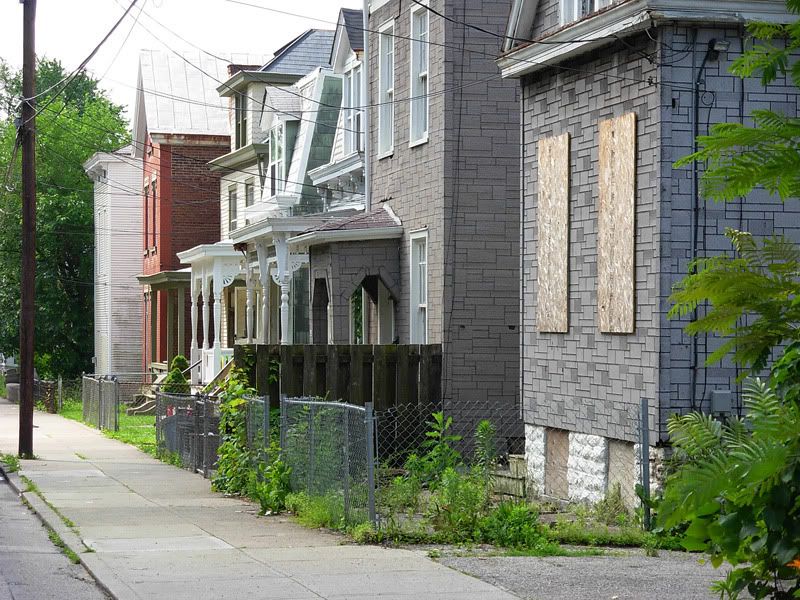 The core of the Sedamsville neighborhood consists of three streets – Delhi Avenue, Steiner Avenue and Sedam Street – nestled in a valley between Embshoff Woods Nature Preserve and Mount Echo Park.
The core of the Sedamsville neighborhood consists of three streets – Delhi Avenue, Steiner Avenue and Sedam Street – nestled in a valley between Embshoff Woods Nature Preserve and Mount Echo Park.
Recent estimates are that 278 people call the area home.
"It's just a place to live, and you drive away to get someplace," says John Klosterman, who over the last 20 years has been rehabilitating neighborhood buildings for mostly low-income tenants.
Of the 149 houses in the core area, 65 are for sale, in foreclosure, or condemned.
"Nobody ever goes down to Sedamsville," Klosterman says. "Not unless they get detoured up Delhi. And it looks pretty grungy, so you want to get through it as quickly as possible. You might get shot. But it's the lowest crime rate in the City of Cincinnati. And people don't realize that."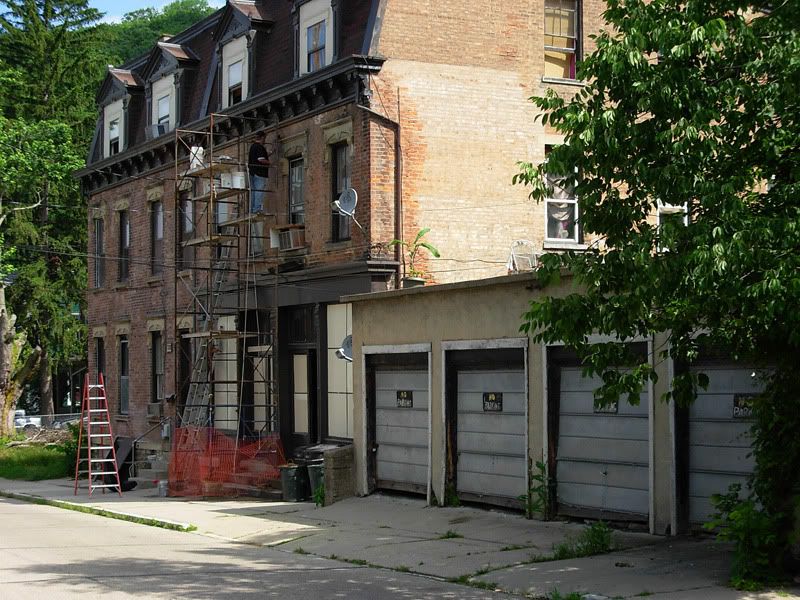 A 'New Sedamsville'
A 'New Sedamsville'
In March, a 42-page "New Sedamsville" business plan, written by business partner Jim Grawe, called for an investment in neighborhood infrastructure, a zoning overlay, and $1.7 million in gap financing.
According to the plan, the financial backing could give Klosterman and Grawe the ability to buy out the remainder of the available properties, giving them control of nearly 75 percent of the neighborhood.
It's the culmination of Klosterman's 20-year vision, and he estimates that they could transform Sedamsville by tearing down 25 blighted properties, rehabilitating 101 properties, and building 78 new housing units.
"Geographically, it's the smallest community, and there's no other encroaching neighborhoods," he says. "It's got the right things wrong with it, so it's amazing how it hasn't caught on."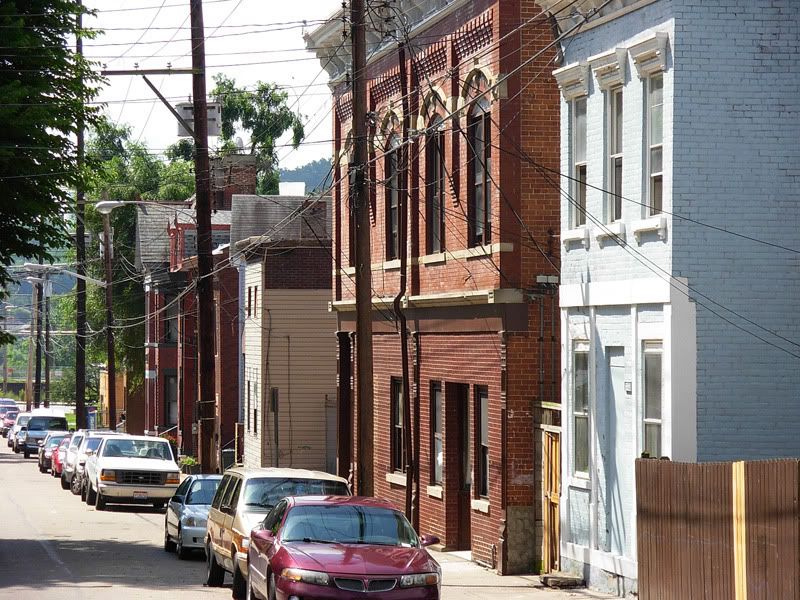 Build around musicians
Build around musicians
"What we'd like to promote is a music community, if you will," Klosterman says. "A music colony. That was Jim's brainstorm."
"What we're considering doing is marketing the core area of Sedamsville as a musician's colony," Grawe says. "Just to get a higher-quality, creative-type person here who maybe doesn't have a lot of money."
With an abundance of available large buildings, Grawe sees plenty of opportunities to make that happen.
"We thought of just clearing out a building and letting musicians just play there," Grawe says. "And we could make it a private club – you don't need a liquor license for a private club – bring your own whatever, and just hang out with lots of entertaining musicians."
But Klosterman says that it's a tough sell because Sedamsville lacks bars, restaurants, grocery stores, and other amenities.
"So we have to create all that," he says.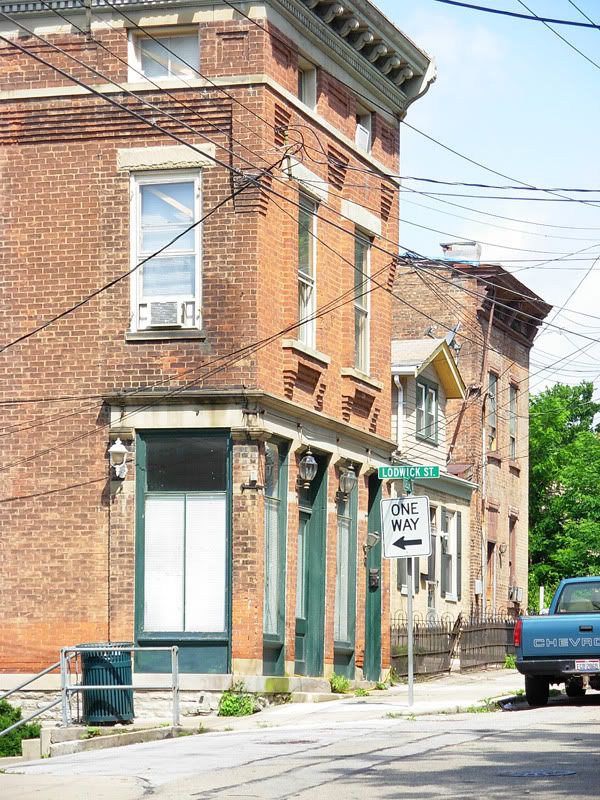 While the neighborhood used to have a grocery store, bakery, and other commercial enterprises, a drop in population made the storefronts no longer viable.
While the neighborhood used to have a grocery store, bakery, and other commercial enterprises, a drop in population made the storefronts no longer viable.
Today, only three commercial businesses are based in the community – a T-shirt factory, a lawn service business, and the Firehouse Nursery.
Klosterman says that he can envision new tenants for some of the surviving storefronts along Delhi Avenue.
"What we would like to do later on is make that a little bar area," he says, pointing to one of the neighborhood's turn-of-the-century buildings. "We could cook food and hamburgers and stuff like that downstairs, bring it up the steps inside. Just a little, small...kind of like Zip's in Hyde Park."
Other ideas include a bakery and coffee shop, an ice cream shop, a pizzeria, or a catering operation.
"All Sedamsville needs is one bar, one good restaurant," Klosterman says. "I will literally give the space away for a year, for free, in any of those places to put a business in there just to get some activity going."
But they aren't even sure if current zoning would support the idea.
"We spoke with Economic Development, and we want an overlay zoning – a mixed-use zoning," Grawe says. "I know they're talking about form-based zoning or smart code zoning or that kind of thing. That's one of the concessions we'd like to have from the City. We're selling a lifestyle here, and if we could attract those kinds of people, that's what it's going to take."
Grawe says that's how the neighborhood was zoned initially.
"The zoning laws changed over the years," Grawe says. "Now, they're reverting back to that."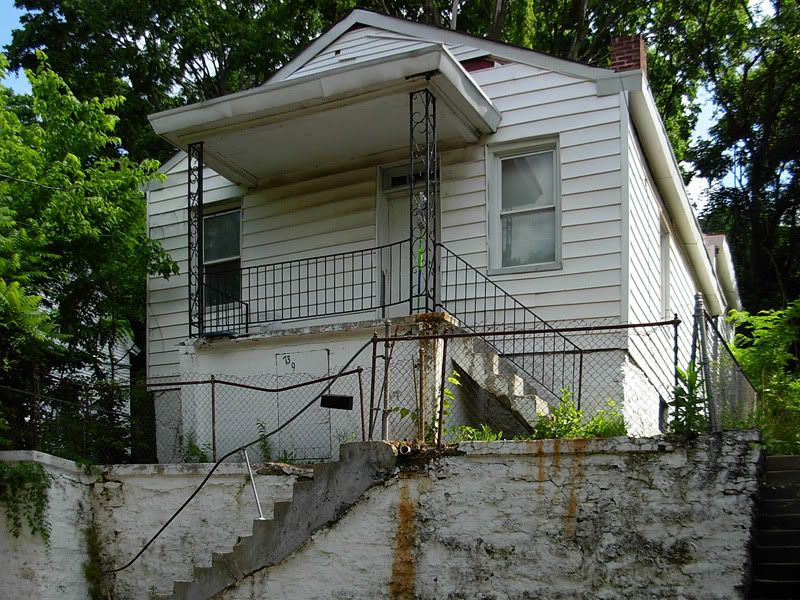 A creative surge
A creative surge
The same idea would be applied to the many vacant residential properties, where Klosterman says he'd be willing to charge just enough rent to allow him to pay the mortgages.
"I've got enough properties that I would give away space in apartments," he says. "We could rent that for a trade-off of a musician playing Saturday night with his band, you get the place for free. I don't care. We have to have some income from some of these places, but a couple hundred bucks for a musician for one bedroom and a little practice area...some of them are 600 or 700 square feet, a nice size."
The hope is that a surge of creative residents will help brand the neighborhood as a cool, welcoming, underground place.
"It can become trendy for any reason," Grawe says. "But once it's perceived as trendy by the right class of people, then they come in and they start doing it. I think the business plan speaks to that, and hopefully lays the foundation for that."
"And at least you've narrowed it down to one community, a musician's community, where they'll feel accepted going there," Klosterman says. "Where if they're playing their music on their porch, you're surrounding by people who either like to entertain or like to be entertained." 'I'm not the problem, I'm part of the solution'
'I'm not the problem, I'm part of the solution'
"If we were in it for the money, we would have never done it," Klosterman says. "It's amazing how 20 years flies by."
Klosterman purchases many of his properties through sheriff's sales – one, condemned by the City, was bought for $20 plus $500 in board-up fees. Another was picked up recently for $1,800.
"Stuff is so very reasonable here," he says. "But it's just the maintenance issues to keep up with all of this stuff while we wait to launch."
Because 70 percent of the neighborhood's buildings were constructed before 1937 and have recently been held by slumlords or low-income tenants, many have severe maintenance issues.
"So you've got a lot of work that these people didn't do, which makes them in such poor condition when I get them," Klosterman says. "But they're historically viable as the fabric of the community holds together to re-do. But it takes talent, it takes money, and it takes patience. Of which the City has none."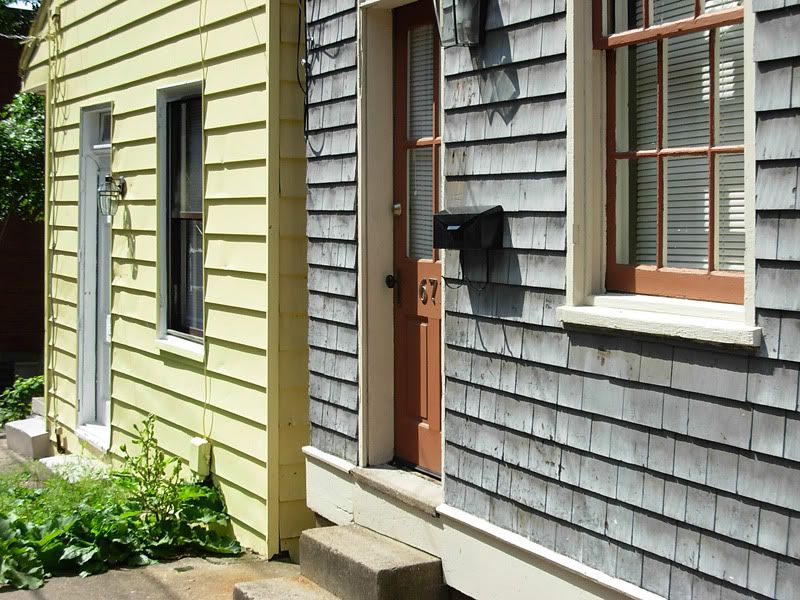 Due to a limited amount of funds, Klosterman generally rehabs only one or two properties at a time.
Due to a limited amount of funds, Klosterman generally rehabs only one or two properties at a time.
"It's all I can do," he says. "I'm only one person, and I'm the only developer in Sedamsville. The rest of them are slumlords. I'm one of the very few landlords that gives a shit about their properties."
But he says that it's becoming emotionally and economically draining.
"It's getting old," Klosterman says. "And the City, it's not that they're badgering me, but they are. Every time I buy a building, it's like, 'Well, you have to have a vacant building maintenance license, the thing's condemned, we're gonna haul you into housing court.' People see me around here nicely dressed on a Friday and they're like, 'Oh, you've been to housing court.'"
Klosterman just wants the City to buy in to the business plan; In 20 years, he has never received so much as a phone call from the City, he says.
"So, either I have to get full understanding by the City to just leave me alone – I'm not the problem, I'm part of the solution," he says. "It really gets so frustrating working with the City, you just cannot believe it. I mean, they're just not understanding. I'm trying to save one of the oldest communities in the City of Cincinnati."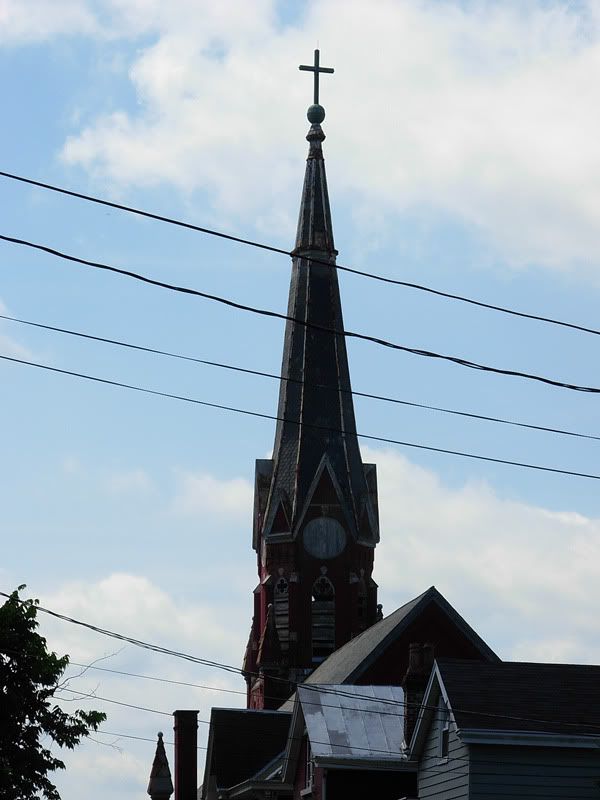 Repurposing an icon
Repurposing an icon
The spire of Our Lady of Perpetual Help Church towers over Sedamsville, its peeling paint belying the possibilities that the building holds.
In 1995, fearing that the iconic structure might be razed, Klosterman purchased the church from the Archdiocese of Cincinnati.
Code violation orders against Klosterman for the property were recently dropped, but the building still needs some work.
He's now working through Department of Community Development director Michael Cervay's office to attract City funding for stabilization, and he says that the City has indicated that it's in no hurry to tear the church down.
"Which is counterproductive to doing something with it," Klosterman says. "So, why don't you give us some money – $30,000 to $40,000 – to re-do the box gutters and fix the bricks. Oh, and now they stole the downspouts because they found it they were copper, just two weeks ago. And I just take a deep breath and keep going, because what else can you do?"
Grawe says they would be willing to "give" the church to somebody who would redevelop the property "in a manner that would complement the business plan".
"We need to find somebody who wants to take advantage of an opportunity – and profit from it himself – to invest in the church, to develop it into something that's the center of a progressive community," Grawe says. "We're thinking about a music venue. I think a music venue would be pretty damn cool."
"But they have to keep the stained glass windows, they can't sell any of the architectural elements," Klosterman says. "It's a small church, but it's not a tremendously high-maintenance thing. The steeple's the biggest thing – it needs to be painted and all that stuff."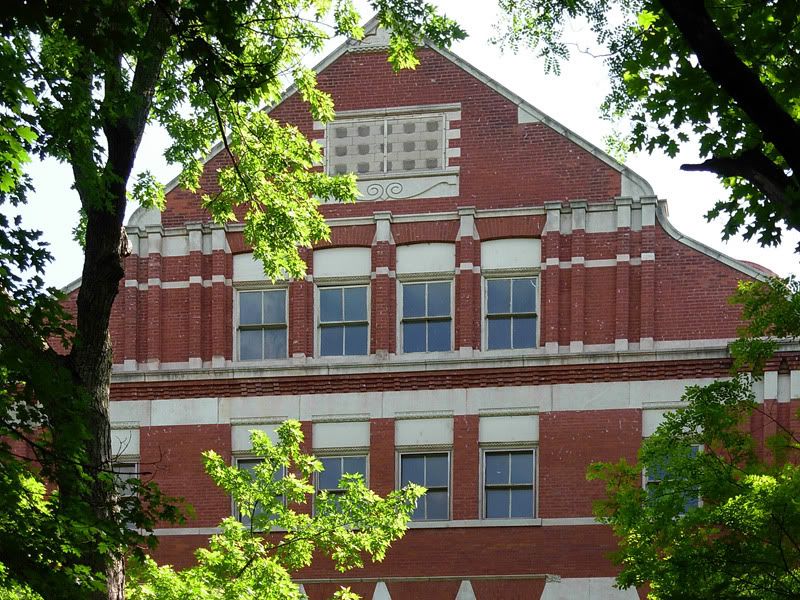 A new center
A new center
The plan from the City calls for a "center of town", and Klosterman and Grawe believe it should be located on the hillside behind the old Sedamsville School, between Steiner and Delhi avenues.
"We think this is where it needs to be, right in back of the school," Grawe says.
Klosterman owns the school, which currently houses apartments, via land contract.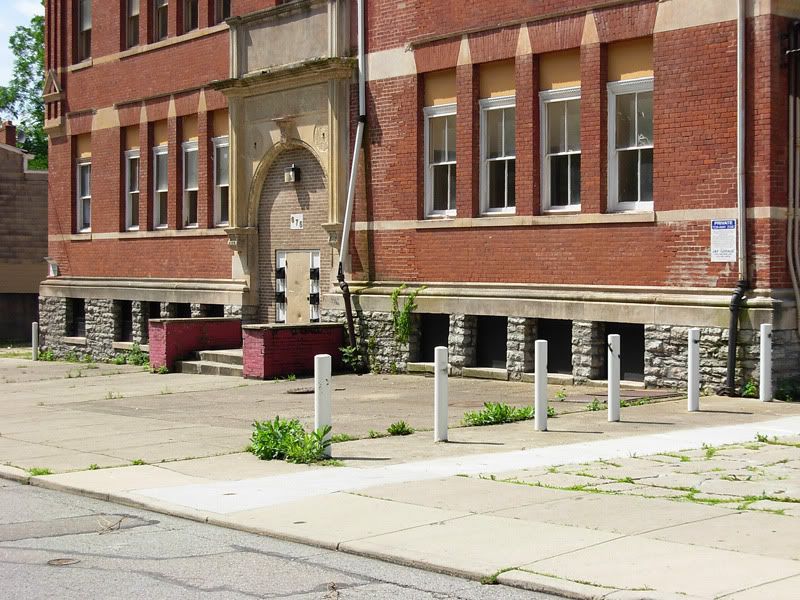 A few weeks ago, kids kicked in the windows and stole copper from four apartments, causing between $20,000 and $25,000 in damage.
A few weeks ago, kids kicked in the windows and stole copper from four apartments, causing between $20,000 and $25,000 in damage.
"The City doesn't care," Klosterman says. "That's the price you pay for doing development in the City of Cincinnati."
Eventually, Klosterman and Grawe would like to see the creation of a two-terraced hillside, with a performance space on the top terrace.
A majority of the old oak trees would be kept, and spaces would be created for people to sit and gather.
The school could be converted for community use.
"We talked to Economic Development the other day and made that proposal and said, 'Look, it's your suggestion that this is what you need, why don't you invest some public dollars in the public realm so that we can, it turn, attract some private investment,'" Klosterman says. "'We'll donate the property to you in order to do that.' And they said, 'Well, how much is it going to cost?' So they always want someone else to do their work for them, you know?"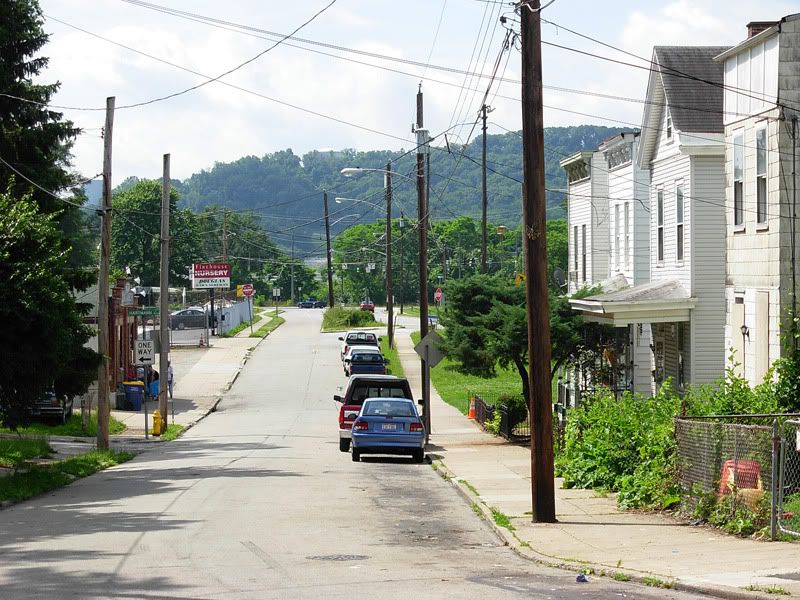 Generating interest
Generating interest
So far, developer interest has been spotty at best.
"Arn Bortz toured this area and was very intrigued," Klosterman says. "Model Management has been down here as well. Both agreed that we could put houses on both sides [from Delhi Avenue to Sedam Street]. The views...can you imagine the views out the back yard with a deck to the Embshoff Park Preserve?"
Klosterman also has an option for 3/4 of an acre on the hillside across Fairbanks Avenue, where he'd like to build a small cottage settlement.
"We've talked to Embshoff Park Preserve, and they've said that they'd put horse trails in," Klosterman says. "And we could put fences in and have horse crossings going across Fairbanks and over into Sedamsville, and just give it a real nice feel of – it's an exclusive area."
But while they're eager to get the word out, both Klosterman and Grawe are aware of what can happen when word gets out too fast.
"It's kind of a Catch-22," Grawe says. "You don't want to make it too public for fear that investors are going to come down here and speculate and drive the price up, at the same time you've got to get the word out to the people that can make it happen and can profit from it as well."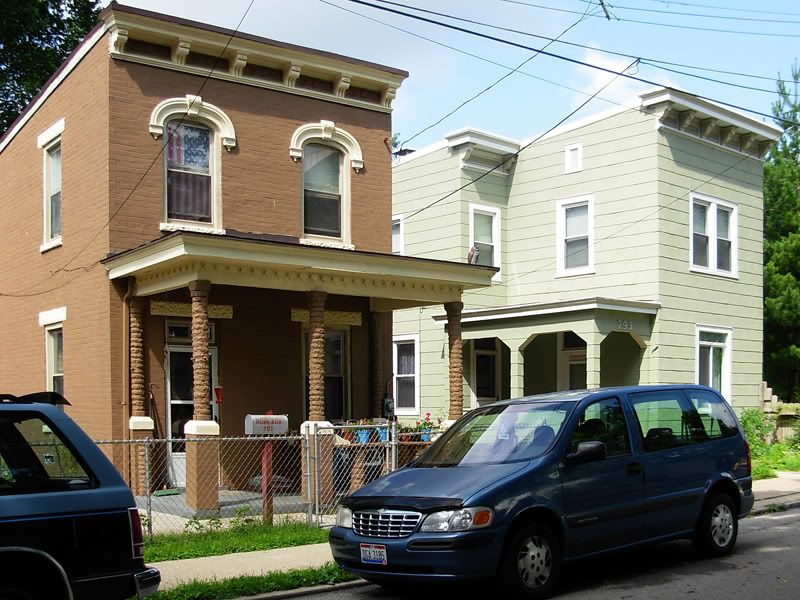 West Riverside Drive?
West Riverside Drive?
Sedamsville is a little-known neighborhood, but there are differing opinions of why – a lack of resources, its relative poverty, its lack of government representation.
"You've got people going over to the East Side buying stuff on what is now called 'Riverside Drive,'" Klosterman says. "Well, we don't have the leadership here, as we spoke to in the business plan. But there's no reason why we can't call this 'West Riverside Drive' instead of River Road. Just those image things that they did over there, well, why can't we do it over here? Because nobody's asked."
To Klosterman, this problem exists for all of the West Side neighborhoods.
"The Kroger up on Warsaw is the best thing they've done in 20, 30 years over there," Klosterman says. "But the eastern side of town, Hyde Park, boy they'll put new lights in and new sidewalks...Mount Adams...they've got the tax base up there. Well, they could have the tax base here, as well. But it's going to take 15 years to start to get it back because of the tax abatement."
He also believes that the City's being short-sighted by even considering the Queensgate Terminals container-to-barge operation that's been proposed for Lower Price Hill's riverfront, and he's not buying the promise that millions in tariff revenues will be channeled into the West Side neighborhoods.
Instead, he believes that money will go into the general fund and end up financing more beautification projects in Hyde Park, Mount Lookout, and Oakley.
"We almost have to stop that before we even start working on Sedamsville," Klosterman says. "I mean, who wants to drive past that, as eco-friendly and green as they say it's going to be?" More cheerleaders needed
More cheerleaders needed
"Where can I get some money?" Klosterman says. "We'll pay it back, we promise. I mean, $1.7 million is chump change. And I would leverage all of my properties to get it if I knew a bank that would give it to me."
Klosterman says that he and Grawe are urban planners, but, not being politicians, they're not entirely sure where to go next.
And both believe that one possible source, the City of Cincinnati, is being evasive in assisting with their proposal.
"At least you'd like them to say, 'Hey, it's a great idea and I support you,'" Grawe says. "You need cheerleaders within the City, and there are none. All they're trying to do is get their paycheck and do the least amount of work possible, it seems like." "The cheerleading is helpful," Klosterman says. "But it would be so much nicer to have the fun of redeveloping, because that's what we do. We do historic rehab, and it's just so delightful to see buildings come back that are, if you would have seen them before, you just wouldn't believe it."
"The cheerleading is helpful," Klosterman says. "But it would be so much nicer to have the fun of redeveloping, because that's what we do. We do historic rehab, and it's just so delightful to see buildings come back that are, if you would have seen them before, you just wouldn't believe it."
Grawe sometimes wonders why the City even has an Economic Development Department.
"I'm sitting here talking to the head of Economic Development for God's sake, and you're asking me to come up with a figure on what it costs to put a parking lot in?" Grawe says. "Give me a damn break! You're the one who said we need parking down here, you're the one who came up with the plan – the City – my tax dollars helped pay for the plan, and now you turn around and you're asking me to come up with the numbers? Isn't there someone in this City who can look at a vacant piece of property and tell me what it costs to tear down some buildings and pave it?"
They have also been told to have a private developer price the project out, with no guarantee of winning the contract.
"And you're asking me to have a private developer do that?" Grawe says. "What is his incentive to do that for me? Is he going to get the job if, in fact, it's in the budget that gets passed? Are you going to honor him with the contract, then, for doing the work? I mean, how difficult can you make it for a guy?" Klosterman says that some very preliminary estimates from "people in the know" indicate that implementation of the business plan could result in a $55 million project that could more than double the area's population to 579.
Klosterman says that some very preliminary estimates from "people in the know" indicate that implementation of the business plan could result in a $55 million project that could more than double the area's population to 579.
"That's a chunk of change," Klosterman says. "For economic activity, materials at Lowe's and Home Depot, and all the grocery stores and restaurants in this area, to say nothing of what it employs. But you've got to have somebody to jumpstart the damn thing."
In the meantime, Klosterman and Grawe will continue to meet with the City, and with possible project funders.
"We need to move population back from the suburbs," Klosterman says. "What better place than Sedamsville?"
Previous reading on BC:
Sedamsville fighting for another church; New business plan proposes 'New Sedamsville' (3/24/09)
St. Martin's German Evangelical Church, 1892-2008
Demolition begins on historic Sedamsville church (10/2/08)
Centerpiece of historic Sedamsville threatened (8/22/08)
City has little say in Sedamsville demolitions (5/14/08)
Tuesday, July 14, 2009
Can $1.7M save Sedamsville?
Posted by
Kevin LeMaster
at
5:10 AM
![]()









